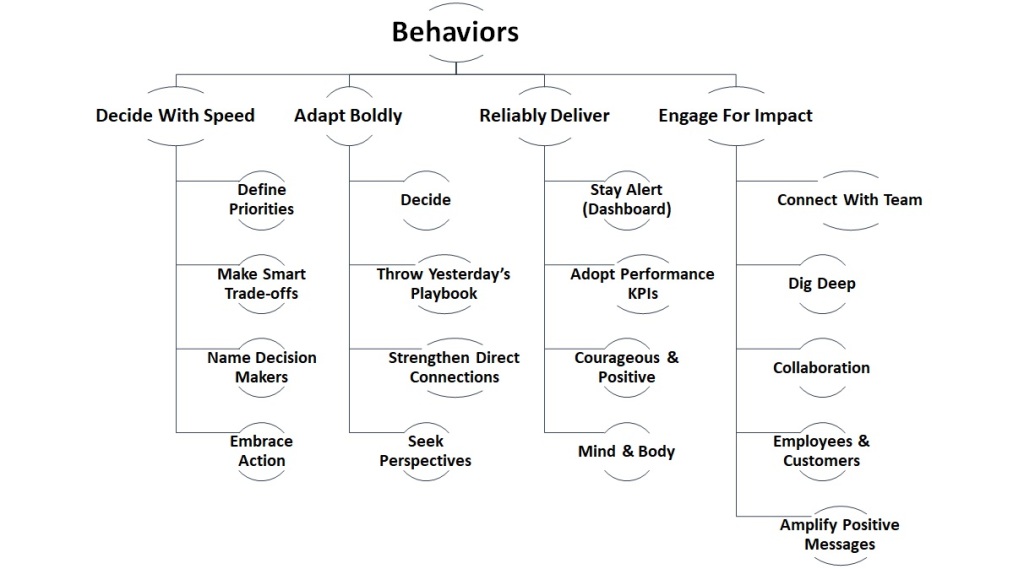BEHAVIOURS THAT HELP LEADERS MANAGE A CRISIS
The roles and responsibilities of business leaders have dramatically changed in the past few weeks. Before COVID-19, leaders in high-growth companies were focused on fostering innovation, driving revenue, and gaining market share. Today, many of those same leaders must make rapid decisions about controlling costs and maintaining liquidity. They may encounter unforeseen roadblocks — supply chain issues, team shortages, and operational challenges — that drastically alter the scope of their roles and priorities.
All the while, they and their teams are navigating health and safety concerns, working remotely, and supporting their families through the pandemic. Those in charge will be tested in areas where they have not fully developed their leadership muscles, and the learning curve will be steep. To move forward in a crisis, leaders need to cultivate some behaviours in themselves and their teams. They must decide with speed over precision, adapt boldly, reliably deliver, and engage for impact.

Behaviour 1: Decide with speed over precision.
The situation is changing by the day — even by the hour. The best leaders quickly process available information, rapidly determine what matters most, and make decisions with conviction. During a crisis, cognitive overload looms; information is incomplete, interests and priorities may clash, and emotions and anxieties run high. Analysis paralysis can easily result, exacerbated by the natural tendency of matrixed organizations to build consensus.
Leaders must break through the inertia to keep the organization trained on business continuity today while increasing the odds of mid- to long-term success by focusing on the few things that matter most. A simple, scalable framework for rapid decision-making is critical.
- Define priorities. Identify and communicate the three to five most important ones. Early in the crisis, those might include employee safety and care, financial liquidity, customer care, and operational continuity. Document the issues identified, ensure that leadership is fully aligned with them, and make course corrections as events unfold.
- Make smart trade-offs. What conflicts might arise among the priorities you have outlined? Between the urgent and the important? Between survival today and success tomorrow? Instead of thinking about all possibilities, the best leaders use their priorities as a scoring mechanism to force trade-offs.
- Name the decision makers. In the central command “war room,” establish who owns what. Empower the front line to make decisions where possible, and clearly state what needs to be escalated, by when, and to whom. The default should be to push decisions downward, not up.
- Embrace action, and don’t punish mistakes. Missteps will happen, but research indicates that failing to act is much worse.
Behaviour 2: Adapt boldly.
Strong leaders get ahead of changing circumstances. They seek input and information from diverse sources, are not afraid to admit what they don’t know, and bring in outside expertise when needed.
- Decide what not to do. Put a hold on large initiatives and expenses, and ruthlessly prioritize. Publicize your “what not to do” choices.
- Throw out yesterday’s playbook. The actions that previously drove results may no longer be relevant. The best leaders adjust quickly and develop new plans of attack.
- Strengthen (or build) direct connections to the front line. In triage situations, it’s crucial to have an accurate, current picture of what is happening on the ground. One way is to create a network of local leaders and influencers who can speak with deep knowledge about the impact of the crisis and the sentiments of customers, suppliers, employees, and other stakeholders. Technology can bring the parties together.
- Seek different perspectives. The successful crisis leader seeks out individuals who have a different perspective on an issue. They include individuals with whom they may not agree and whose advice may be contrary to that of their closest advisers. Effective leaders extend their antennae across all the ecosystems in which they operate.
Behaviour 3: Reliably deliver.
The best leaders take personal ownership in a crisis, even though many challenges and factors lie outside their control. They align team focus, establish new metrics to monitor performance, and create a culture of accountability.
- Stay alert to and aligned on a daily dashboard of priorities. Leaders should succinctly document their top five priorities (on half a page or less) and ensure that those above them are in accord. Review performance against those items frequently — if not daily, perhaps weekly — and make sure that leaders share this information with direct reports. Review and update your “hit list” at the end of each day or week.
- Set KPIs and other metrics to measure performance. Choose three to five metrics that matter most for the week, and have leaders regularly report back on each.
- Calm, courageous and positive. They feel a sense of urgency and remain even tempered. They recognize that an organization, a country or the world is watching them and know that how they present themselves will provide non verbal signals to the audience. They will deliver bad news when they need to and do it in a way that avoids panic and provides a realistic level of hope for the future. Above all, they are courageous enough to make decisions they believe to be the right ones, regardless of whether they are the more popular ones.
- Keep mind and body in fighting shape. To reliably deliver, leaders must maintain their equanimity even when others are losing their heads. Establish a routine of self-care: a healthy diet, exercise, meditation, or whatever works best for you. Stock up on energy, emotional reserves, and coping mechanisms.
Behaviour 4: Engage for impact.
In times of crisis, no job is more important than taking care of your team. Effective leaders are understanding of their team’s circumstances and distractions, but they find ways to engage and motivate, clearly and thoroughly communicating important new goals and information.
Leaders need to reiterate new priorities frequently to ensure continued alignment in this time of constant and stressful change.
- Connect with individual team members. Reach out daily for a “pulse check” with least five; block out time on the calendar to do this. Relate on a personal level first, and then focus on work.
- Dig deep to engage your teams. When communication breaks down and leaders act without team input, as can more easily happen when work is remote, they get sub-par results. Good leaders are able to see the big picture. They can see all of the moving parts and understand what is cause and what is effect. They can dig deep into detail without being mired in it and quickly develop a very detailed knowledge of the issues. This ability further enhances their capacity to view the problem realistically.
- Collaboration. The best leaders know they can’t do everything themselves. They understand, however, that a long-term solution requires the input and involvement of many stakeholders. They identify those individuals and work together towards a solution that most support and most can live with.
- Ensure a focus on both customers and employees.
- To support customers: Reach out, but first do no harm. Track and document intel across your customer base. To strengthen relationships and build trust, keep the focus off yourself and explore how you can truly help your customers.
- To support employees: Lead with empathy and a focus on safety and health. Compassion goes a long way during turbulent times. Find ways to lend material aid to frontline employees who cannot work remotely.
- Collect and amplify positive messages —successes, acts of kindness, obstacles that have been overcome. Many companies are tied to a noble purpose. Whatever your purpose, celebrate your daily (often unsung) heroes. Simply staying productive in these times is heroic.
Content Curated By: Dr Shoury Kuttappa

